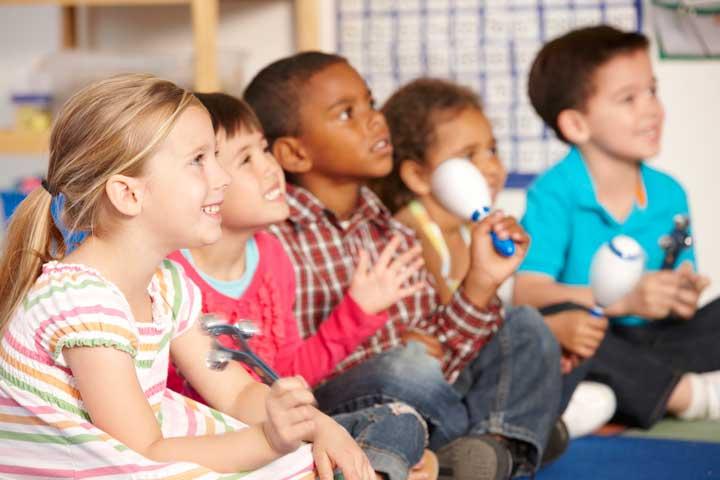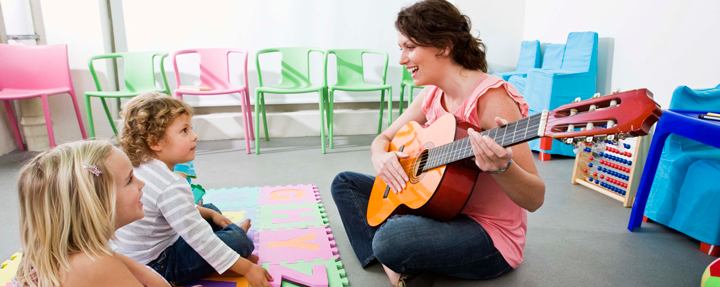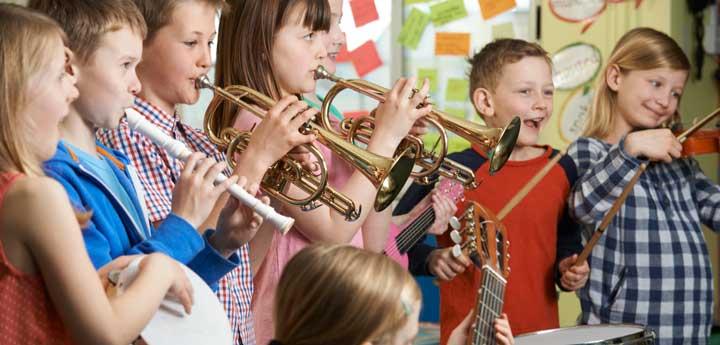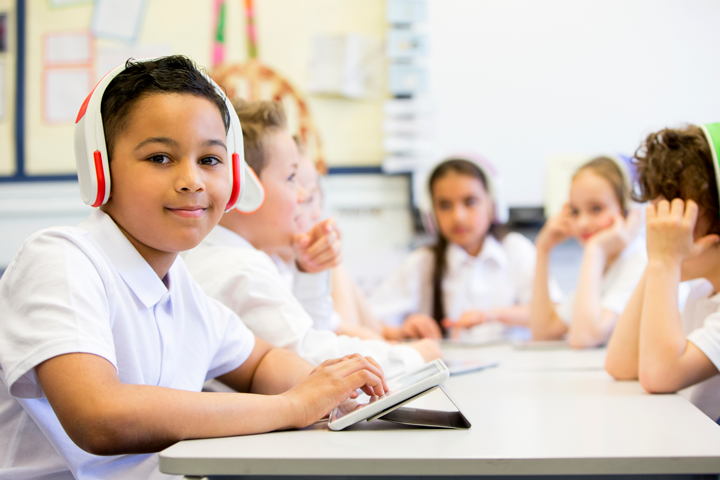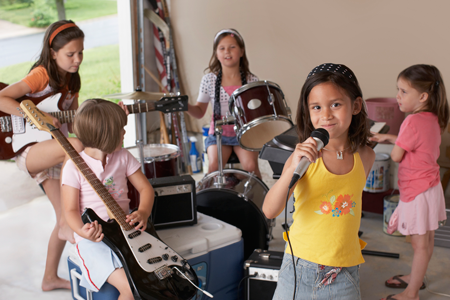Introduction
Welcome to the module on the revised music Texas Essential Knowledge and Skills (TEKS) that will guide elementary school curriculum and instruction for the State of Texas.
Foundations of Music- Beat
- Rhythm
- Melody
- Dynamics
- Tempo
- Timbre
- Form
- Singing
- Playing instruments
- Reading, writing, improvising, and creating music
- Participating in part-work
- Listening and responding to music
- The study of the history and culture of music
Elementary music classes establish the foundation of music learning. Students are involved in active music-making. They sing, play instruments, and move to music from various cultures. They read, write, and reproduce rhythmic and melodic patterns. Students emerge as independent music-makers and begin to engage in part-work. They learn to listen; focus on what they are listening to; use correct vocabulary; and identify, describe, and categorize myriad sounds. The elementary music foundation also includes learning to create and improvise rhythmic and melodic patterns and identify voices and instruments from various cultures. Students learn to relate music to history and culture and to connect it to other academic disciplines.
Elementary students experience music in many ways. Initially, they listen to short musical selections and distinguish between like and unlike passages. Through a carefully planned sequence of activities that includes singing, playing, and listening, students learn to look at and replicate a passage of notes with accurate pitch, rhythm, dynamics, and tempo by singing, playing, or inner hearing.
Foundations of Music
Elementary students begin by learning to keep a steady beat and then work to understand rhythm and how it divides in comparison to the beat. Students explore their voices and learn to recognize and produce high and low sounds. Gradually students learn to listen to a melodic line and match it with its visual representation. This exercise enables students to use both their ears and eyes to recognize phrases in order to identify forms such as AB, ABA, theme, variations of a theme, and rondo. With more experience, children learn to hear the difference between two similar phrases, for example, those having the same melodic line but different rhythms. From simple learning processes that begin at the primary levels, students advance to analyzing longer and more complicated musical works in which form is also created by harmony and texture.
Elementary school students experience music by chanting, singing, playing, moving, reading, writing, improvising, and creating. Leaving out even one element shortchanges students from learning the multi-faceted discipline of music. The basic elements provide a foundation for advanced development as students learn to sing or play their part while others play a different part, improvise, create and compose accompaniments to music, and evaluate music and musical performances.
To enable all students to realize their musical potential, a solid music program based on scaffolded course content should be implemented in elementary school.
Activities that involve music but are not based on sequenced content as described by the TEKS rarely build a foundation for musical achievement. Class musicals, while they create visibility for programs, should not preclude the well‐rounded instruction necessary for the development of sequenced content knowledge and skills. Similarly, excursions to concerts and performances provide good exposure to music but are only one component of a quality music education.
Objectives
By the end of this module, we hope that teachers will be able to demonstrate the following skills in relation to the elementary music TEKS:
- Articulate the differences between the original and revised elementary music TEKS for kindergarten through grade 5 students
- Identify the guiding principles and concepts of the revised TEKS
- Make plans to revise curriculum, instruction, and learning experiences in order to align with the revised TEKS
Please take a moment to familiarize yourself with the revised elementary music TEKS. Review the elementary music TEKS comparison that shows the original and revised music TEKS. Refer to this chart as you consider some of the changes in each strand. The side‐by‐side chart shows the changes in the elementary school music TEKS from the original TEKS to the corresponding revised TEKS.
Overview of the Revised TEKS
- More specificity within the student expectations
- Vertical alignment in the music TEKS from grade level to grade level
- A focus on the creative process, real‐world relevance, higher‐level thinking, problem-solving skills, and the knowledge of concepts and skills that are required for active music‐making
Take a moment to review the elementary music TEKS alignment chart for elementary school music. The document shows how skills are scaffolded from one grade level to another. Even though the TEKS writing teams for music were organized as kindergarten through grade 2, grades 3‐5, middle school, and high school, the teams met together during the writing process to ensure a spiraling of concepts, knowledge, and higher‐level thinking skills.
When reviewing the revised TEKS, it is important to understand that when "including" is used, it means that all the stated skills, concepts, or examples must be taught. When the words "such as" are used, it means that stated skills and concepts are simply examples of what should be taught.
Introduction to the Strands
This chart shows the transition from the four strands of the original fine arts TEKS to the revised strands which will be in place starting in the 2015‐16 school year. The next few lesson sections will look at the revised strands in detail.
| Original TEKS | Revised TEKS |
|---|---|
|
|
The revised TEKS are organized into four strands. The strands provide a broad and unifying structure for organizing the knowledge and skills students are expected to demonstrate. Each of the strands serves distinct learning purposes.
Music Strands
Foundations: music literacy
The student describes and analyzes musical sound.
This strand fosters the reading, writing, reproducing, and creating of music, thus developing a student's intellect.
Creative expression
The student performs a varied repertoire of developmentally appropriate music in informal or formal settings.
In this strand, students apply their music literacy and critical thinking skills to sing, play, read, write, and move to music.
Historical and cultural relevance
The student examines music in relation to history and cultures.
This strand consists of standards for experiencing music periods and styles in order for students to understand the relevance of music to history, culture, and the world. This strand includes the relationship of music to other academic disciplines and the vocational possibilities music offers.
Critical evaluation and response
The student listens to, responds to, and evaluates music and musical performances.
This strand is concerned with the critical listening that aids students in analyzing, evaluating, and responding to music in order to develop criteria for making critical judgments and informed choices.
Changes to the Strands
Perception + part of Creative expression/performance = Foundations: music literacy
This module will focus on the kindergarten through grade 5 music TEKS. Please review the course discovery elementary music to get an overview of the elementary school music TEKS and examples of what using the revised strands might look like in the classroom. Take a moment to review the three charts before we discuss each strand. Keep the charts handy to refer back to them as we review each strand.
Foundations: Music Literacy (Kindergarten)
Here is an example of how the student expectations from the original Perception strand were revised and moved to Foundations: music literacy in the kindergarten TEKS. In the original TEKS strand of Perception, students were asked to analyze sounds such as voice and the various timbres of instruments. This analysis of sound is now included in the revised Foundations: music literacy strand as we build the foundation for students' literacy in music. Additionally, there is more depth to the identification of sound in the revised TEKS. For example, in kindergarten, students are now asked to identify the differences between five voices, including singing, speaking, inner, whispering, and calling voice instead of simply identifying the differences between singing and speaking voices. Students are also asked more specifically to identify the differences between adult and child singing voices and to identify the timbre of instrument families rather than simply identifying individual instruments.
Now visit the course discovery kindergarten music to view how the Foundations: music literacy strand is taught in kindergarten music classes. You may also wish to view the examples provided to see what teaching with the revised TEKS might look like in a kindergarten music classroom.
Perception Moves to Foundations: Music Literacy
| Original TEKS | Revised TEKS |
|---|---|
|
Music, Kindergarten (b)(1) Perception. The student describes and analyzes musical sound and demonstrates musical artistry. The student is expected to: (A) Identify the difference between the singing and speaking voice; and |
Music, Kindergarten (b)(1) Foundations: music literacy Perception. The student describes and analyzes musical sound and demonstrates musical artistry. The student is expected to: (A) identify the differences between the five voices including singing, and speaking, inner voice, whispering, and calling voices; and instruments
|
Foundations: Music Literacy (Grade 2)
Now take a look at a lesson example of the original Creative expression/performance strand for grade 2, in which the student expectation is to read and write music notation. Notice the increased specificity in the revision. The second grade student is now expected to read, write, and reproduce pentatonic melodic patterns using standard staff notation and read, write, and reproduce basic music terminology, including the specific tempo markings of allegro/largo and the dynamic markings of forte/piano. The word "reproduce" is used throughout the TEKS, and it simply means for the students to reproduce a pattern in some way, perhaps by clapping, tapping, singing, or playing instruments. The new specificity added to the development of music literacy will aid music educators as they develop a sequential curriculum for their students.
Visit the course discovery grade 2 music to view how the Foundations: music literacy strand might be taught in grade 2 music classes. You may also wish to view the examples provided to see what teaching with the revised TEKS might look like in a grade 2 music classroom.
Creative Expression/Performance Moves to Foundations: Music Literacy
| Original TEKS | Revised TEKS |
|---|---|
|
Music, Grade 2 (b)(3) Creative expression/performance. The student reads and writes music notation. The student is expected to: (A) read and write simple music notation, using a system (letters, numbers, syllables); and |
Music, Grade 2 (b)(2) Foundations: music literacy. Creative expression/performance. The student reads, and writes, and reproduces music notation. Technology and other tools may be used to read, write, and reproduce musical examples. The student is expected to: (A)(B) read, write, and reproduce pentatonic melodic patterns using standard staff notation; and read and write music that incorporates basic rhythmic patterns in simple meters. |
Foundations: Music Literacy (Grade 3)
Visit the course discovery grade 3 music to view how the Foundations: music literacy strand might be taught in grade 3 music classes. You may also wish to view the examples provided to see what teaching with the revised TEKS might look like in a grade 3 music classroom.
Creative Expression/Performance Moves to Foundations: Music Literacy
| Original TEKS | Revised TEKS |
|---|---|
|
Music, Grade 3 (b)(3) Creative expression/performance. The student reads and writes music notation. The student is expected to: (A) read music notation, using a system (letters, numbers, syllables); |
Music, Grade 3 (b)(2) Foundations: music literacy. Creative expression/performance The student reads, and writes, and reproduces music notation using a system. Technology and other tools may be used to read, write, and reproduce musical examples. The student is expected to: (A) read, write, and reproduce rhythmic patterns using standard notation, including four sixteenth notes, whole notes, whole rests, and previously learned note values in 2/4 and 4/4 meters as appropriate write music notation, using a system (letters, numbers, syllables); |
Highlights of the Foundations: Music Literacy Strand
The new language included in the Foundation: music literacy strand includes read, write, and reproduce. The intent of reproducing is active music‐making, such as playing, singing, clapping, tapping, and performing for the class. Shown here are some examples of the specificity of concepts that have been developed in this strand with examples of how a district's local curriculum might develop a system for addressing these standards. The TEKS are standards and do not dictate the curriculum or instructional systems a district uses for instruction. Control of the curriculum, instruction, tools, resources, or systems used to teach is held at the local district, on campus, and by teachers through the lesson plans developed for instruction. Take a moment to read the examples of how curriculum decisions can make the TEKS even more specific.
Highlights of the Foundation: Music Literacy Strand
Language"read, write, and reproduce"
(reproduce = perform, play, sing, clap, tap)
Music, Grade 1 (c)(2)(B)
"three tones from the pentatonic scale"
(perhaps, so, mi, la or mi, re, do)
Music, Grade 2 (c)(2)(B)
"pentatonic melodic patterns"
(do, re, mi, so, la or 1, 2, 3, 5, 6)
Music, Grade 3 and Grade 4 (c)(2)(B)
"extended pentatonic melodic patterns"
(low la, low so, and/or high do)
Music, Grade 5 (b)(2)(A)
Read, write, and reproduce rhythmic patterns using standard notation, including syncopated patterns, and previously learned note values in 2/4, 3/4, or 4/4 meters as appropriate.
Because the Foundations: music literacy strand has the most revisions and increased specificity, you might wish to examine this sample of a yearly plan for K‐5 based on teaching the concepts outlined in this strand. Take a moment to review this example and think of ways you might incorporate these spiraling concepts into your curricula and lesson plans.
Creative Expression
When looking at the revised Creative expression strand, notice the addition of student expectations such as "sing tunefully, and sing and play classroom instruments independently or in groups with accurate intonation and rhythm." The attention to tuneful and accurate intonation as a student expectation spirals up through the grade levels and gives additional rigor to the learning in this strand. The review committee articulated increased specificity in the use of terms such as dynamics and tempo as well as other music terms that describe articulation beginning with louder/softer and faster/slower in kindergarten and then spiraling to mezzo piano/mezzo forte, accelerando, and ritardando in grades 4 and 5. Movement and part‐work were concepts not included in the original TEKS but are now included in the revised Creative expression strand.
Visit the course discovery grade 5 music to view how the Creative expression strand might be taught in grade 5 music classes. You may also wish to view the examples provided to see what teaching with the revised TEKS might look like in a grade 5 music classroom.
Movement and Part-Work Added to Strand
Music, Grade 5 (b)(3)
(C) move alone and with others to a varied repertoire of music using gross motor, fine motor, locomotor, and non-locomotor skills and integrated movement such as hands and feet moving together;
(D) perform various folk dances and play parties; and
(E) perform simple two-part music, including rhythmic and melodic ostinati, rounds, partner songs, and counter melodies.
Additions to Creative Expression Strand
- Movement
- Part-work
- Performance of expressive qualities
Changes to the Creative expression strand start with movement, which has been added to this strand. Additionally, the teaching of part‐work is now specifically addressed. Expressive qualities such as dynamics, tempo, and articulation are required, along with specific music terminology. The student is expected to learn to interpret and demonstrate this terminology in their music‐making. Next, we’ll look specifically at how the TEKS changed in this strand.
Creative Expression (Grade 3)
Here are several student expectations from the original grade 3 music TEKS in the Creative expression/performance strand. Notice the broad reference to the music the student is performing based on reading and writing from notation, the prescribed meters, and the symbols and terms referring to dynamics and tempo.
Creative Expression
| Original TEKS | Revised TEKS |
|---|---|
|
Music, Grade 3 (b)(2) Creative expression/performance. The student performs a varied repertoire of music. The student is expected to: (A) sing or play a classroom instrument independently or in groups; and Music, Grade 3 (b)(3) Creative expression/performance. The student reads and writes music notation. The student is expected to: (A) read music notation, using a system (letters, numbers, syllables); |
Music, Grade 3 (b)(3) Creative expression. The student performs a varied repertoire of developmentally appropriate music in informal or formal settings. The student is expected to: (A) sing or play classroom instruments with accurate intonation and rhythm independently or in groups; |
As you prepare students for future instrumental and vocal ensemble work, you are laying the foundation in these early developmental years for student independence on a part while hearing another part. As we have done before in music instruction, we will teach our students about tempo and dynamics but in particular as outlined above in grade 3, we will learn mezzo piano and mezzo forte.
Visit the course discovery grade 3 music to view how the Creative expression strand might be taught in third grade music classes. You may also wish to view the examples provided to see what teaching with the revised TEKS might look like in a third grade music classroom.
Historical and Cultural Relevance (Grade 4)
Visit the course discovery grade 4 music to view how the Historical and cultural relevance strand is taught in grade 4 music classes. You may also wish to view the examples provided to see what teaching with the revised TEKS looks like in a grade 4 music classroom.
Historical and Cultural Relevance
| Original TEKS | Revised TEKS |
|---|---|
|
Music, Grade 4 (b)(5) Historical/cultural heritage. The student relates music to history, to society, and to culture. The student is expected to: (A) identify aurally-presented excerpts of music representing diverse genres, styles, periods, and cultures; |
Music, Grade 4 (b)(5) Historical and cultural relevance. The student examines music in relation to history and cultures. The student is expected to: (A)(B) perform a varied repertoire of songs, music and movement, and musical games from representative of diverse cultures such as historical folk songs of Texas and Hispanic and American Indian cultures in Texas; |
Image: Charles A. Spain, Jr., "TEXAS, OUR TEXAS," Handbook of Texas Online (http://www.tshaonline.org/handbook/online/articles/xet01). Uploaded on June 15, 2010. Modified on May 19, 2014. Published by the Texas State Historical Association.
Historical and Cultural Relevance (Grade 5)
Visit the course discovery grade 5 music to view how the Historical and cultural relevance strand is taught in grade 5 music classes. You may also wish to view the examples provided to see what teaching with the revised TEKS looks like in a grade 5 music classroom.
Historical and Cultural Relevance
| Original TEKS | Revised TEKS |
|---|---|
|
Music, Grade 5 (b)(5) Historical/cultural heritage. The student relates music to history, to society, and to culture. The student is expected to: (A) identify aurally-presented excerpts of music representing diverse genres, styles, periods, and cultures; |
Music, Grade 5 (b)(5) Historical and cultural relevance. The student examines music in relation to history and cultures. The student is expected to: (A)(C) perform a varied repertoire of songs, music and movement, and musical games from representative of diverse cultures such as historical folk songs of Texas and America and European and African cultures in America; |
Again, you will see that examples using "such as" consist of historical folk songs of Texas and America as well as European and African cultures, while "including" is used specifically to teach our national anthem, "The Star‐Spangled Banner."
Connections Found in the Historical and Cultural Relevance Strand Related to Social Studies TEKS
- Grade 4 Texas history: "Texas, Our Texas"
- Grade 5 U.S. history: "The Star Spangled Banner"
Image: Cover of sheet music for "The Star-Spangled Banner" [words by Francis Scott Key], transcribed for piano by Ch. Voss, Philadelphia: G. Andre & Co., 1862.
Critical Evaluation and Response (Grade 5)
Visit the course discovery grade 5 music to view how the Critical evaluation and response strand might be taught in grade 5 music classes. You may also wish to view the examples provided to see what teaching with the revised TEKS might look like in a grade 5 music classroom.
Critical Evaluation and Response
| Original TEKS | Revised TEKS |
|---|---|
|
Music, Grade 5 (b)(6) Response/evaluation. The student responds to and evaluates music and musical performance. The student is expected to: (A) apply criteria in evaluating musical performances and compositions; |
Music, Grade 5 (b)(6) Critical evaluation and response/evaluation. The student listens to, responds to, and evaluates music and musical performances. The student is expected to: (A)(C) exhibit audience concert etiquette as an actively involved listener during varied live and recorded performances; |
Critical Evaluation and Response (Bloom’s Taxonomy)
Students Develop Higher-Level Thinking Skills Through Critical Listening
Kindergarten: Students identify and compare.
Grade 1: Students identify, recognize, demonstrate, distinguish, and respond.
Grade 2: Students practice, recognize, distinguish, and respond.
Grade 3: Students identify, recognize, describe, exhibit, and respond.
Grade 4: Students recognize, describe, exhibit, respond, and justify.
Grade 5: Students identify, describe, exhibit, respond, evaluate, and justify.
How Lessons Change with the Revised TEKS
Download the interactive PDF to record your responses to the following questions:
- What are some ways you could adapt your lesson to embrace the revised TEKS?
- How might you add more specificity to your lesson?
- What are some ways you could spiral the concepts outlined in the revised TEKS in your lesson sequences?
- How might you use the "action verbs" included in the TEKS to increase higher-level thinking skills for your students?
Here is a sample of a five‐lesson sequence using the revised TEKS. Notice the careful crafting of how each strand of the TEKS is represented. The repertoire used in the lessons has easy connections to the Historical and cultural relevance strand. The lessons include critical listening from the Critical evaluation and response strand. Learning the Foundations: music literacy is central to the entire music learning experience. Movement is always used to transition from one learning experience to the next, and the Creative expression strand also plays a major part in lesson construction.
The Revised TEKS with Special Education Considerations
Music teachers make accommodations for 504 and special education students on a regular basis, allowing all students to take part in and benefit from music instruction. Along with all other teachers, a music educator needs professional development regarding 504 and special education accommodations in order to make connections across all disciplines for special needs students. Additionally, music teachers need to be aware of all accommodations required for their students and have easy access to students' plans as well as the resources needed to accommodate all student needs.
Some examples of opportunities for inclusion of special needs students may include the following:
- Having the student whose movement is confined to a wheelchair learn to play percussion in the band
- Helping the struggling math student understand fractions for the first time by understanding the division of sounds in a beat
- Helping the student who struggles emotionally find a creative outlet in music
- Helping the emotionally disturbed or socially awkward student become a part of a team by joining a music program
These and so many more examples are ways that the revised music TEKS can guide you to develop student skills by using kinesthetic, aural/oral, and visual techniques to address all learning styles and reach all learners.
Participating in the student's Individualized Education Program (IEP) or 504 planning meetings can offer a different and valuable viewpoint regarding the students learning and participation in school. You may often be asked to participate in the admission, review, and dismissal (ARD) process for special education students and can give valuable input to a student's IEP and how the music TEKS might assist in the student's learning.
The Revised TEKS with Considerations for English Language Learners (ELLs)
As a music teacher, participating in professional development and even becoming certified to teach English language learners (ELLs) can be of great benefit to ELL students in your classroom. Elementary teachers, through the use of the English Language Proficiency Standards alongside the TEKS, can provide substantial support for ELLs even as they grow proficient in the skills of music and creativity.
Music classes provide great opportunities for students to practice the following skills:
- The student describes and analyzes musical sound and reads, writes, and reproduces music notation
- Use basic music terminology in describing changes in tempo, including allegro/largo, and dynamics, including forte/piano
- Identify simple interdisciplinary concepts relating to music
- Recognize known rhythmic and melodic elements in aural examples using appropriate vocabulary
To help students connect learning, teachers can incorporate the four language domains in music curriculum.
The Four Language Domains
Listening is the ability to understand spoken language, comprehend and extract information, and follow social and instructional discourse through which information is provided.
Speaking is the ability to use spoken language appropriately and effectively in learning activities and social interactions.
Reading is the ability to comprehend and interpret written text at the grade-appropriate level.
Writing is the ability to produce written text with content and format to fulfill grade-appropriate classroom assignments.
The music TEKS directly call for skills in all of these areas. Examples include listening to music and learning to write a critique, reading a text for a song and understanding its poetic or literary meaning, or simply learning to sing a song with proper pronunciation and comprehension. All of these activities can help ELLs as their language skills grow.
Conclusion
In this module, we have discovered these changes in the revised music TEKS:
- More specificity of concepts and terms within the revised student expectation. The revisions to the TEKS will help districts know what specific concepts will be used for instruction in order to create a sequential curriculum.
- Vertical alignment that spirals knowledge and skills from grade level to grade level. The revised TEKS show us age‐appropriate concepts for each grade level.
- Action verbs and revised student expectations that focus on the creative process, real world relevance, higher‐level thinking, problem‐solving and concepts of active music making.
The complexity of the student expectations have been increased through action verbs that lead the instruction to higher‐level thinking skills at each level. As we reflect, revise, and align to be sure we are meeting the expectations of the revised TEKS, we will be on our way to providing the best elementary music education possible so that our students demonstrate 21st century learning, college and career readiness, and creativity. With a well‐crafted lesson, it is easy to explore student expectations from each of the four strands, and it will set the stage for engaging music instruction.
Quiz
Extend Your Learning: Tools and Resources
There are many resources and professional development to help align curriculum and instruction to the revised elementary music TEKS. Listed below are a few that will be beneficial in creating and developing a program. Take a moment to review each one. Bookmark these resources or some of the others used in this module, such as the elementary music TEKS alignment chart, the elementary music TEKS comparison, or the course discovery elementary music.
Tools and Resources
- Revised Elementary Music TEKS
http://ritter.tea.state.tx.us/rules/tac/chapter117/index.html - Organization of American Kodály http://www.oake.org/links/
Professional Development Opportunities for Music Teachers
- Kodály Educators of Texas http://www.kodalytexas.com
- American Orff-Schulwerk Association http://aosa.org/professional-development/


